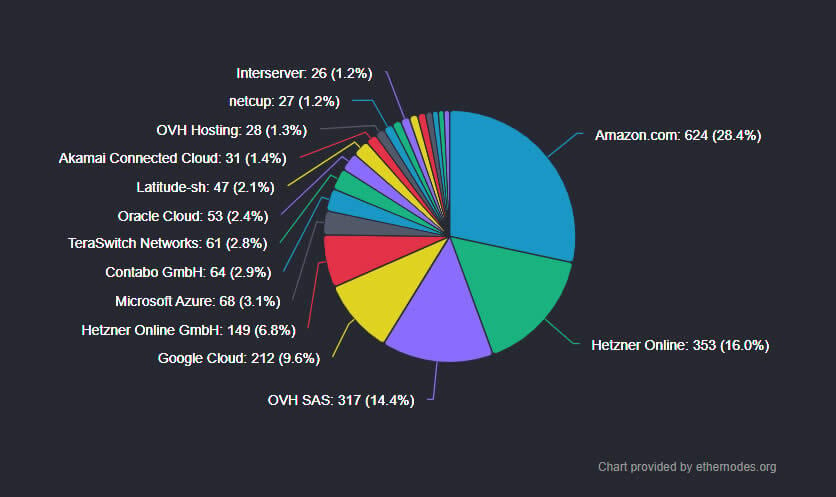A senior Bloomberg analyst was criticised for making a statement about Ethereum. What exactly was he wrong about?
Bloomberg senior ETF analyst Eric Balchunas has provoked a small scandal within the Etherium fan community. All because of one recommendation he made in a now-deleted Twitter post. Specifically, tonight Balchunas shared an excerpt from Benjamin Hart’s book titled “Bitcoin: Beginner’s Guide” and added that ETH is “just not the same or as safe” as Bitcoin. The post was published in response to a request from ETF Store head Nate Geraci to recommend a book about cryptocurrencies.

Bloomberg analysts Eric Balchunas and James Seyffarth made headlines in the cryptocurrency community in the summer of 2023. That’s when the world’s largest investment companies took to filing applications to launch spot Bitcoin-ETFs, and the experts started commenting on them.
It’s worth noting that Balchunas and Seyffarth gave an exact date for the approval of BTC-based exchange-traded funds a few months in advance. In addition, they regularly shared analyses of what is happening with such instruments after their launch.

Bloomberg analyst James Seyffarth
Now, however, an erroneous comment by one of them has sparked criticism from the blockchain community.
Myths about Ethereum: parsing the cryptocurrency’s key “flaw”
A passage in the book claims that the US government could “shut down Etherium” if it pressured Amazon Web Services (AWS) to shut down its cloud services.
According to platform Ethernodes, 28.4 per cent of nodes on the Eth network use AWS as their hosting provider. However, even this level of centralisation is not enough to completely shut down the network.

Hosting distribution for Ethernodes
Amazon Web Services (AWS) provides cloud computing services that host a significant portion of the Etherium infrastructure. The reliance on centralised services raises concerns about external impact on the network. However, since a large number of nodes in the Etherium network depend on AWS, this creates potential vulnerabilities and exposes the cryptocurrency’s weaknesses to any hostile actions by the government or even a single company.
The book also states that government agencies or even terrorist organisations are in a position to resort to the last resort of kidnapping Vitalik Buterin, the creator of Etherium. Using him as a hostage is supposedly able to give attackers a serious advantage in negotiations with the main developers of the blockchain project.
However, the above arguments from Hart’s book are not supported by real evidence. This was reported by Anthony Sassano, a well-known fan of Etherium – here’s his commentary, as quoted by Cointelegraph.
For those wondering, this is the tweet that Eric deleted. Absolute blatant misinformation and almost complete propaganda. You should be very ashamed of yourself for sharing it. And you only deleted it because you didn’t want to deal with people criticising you for it.

Eric Balchunas’ deleted tweet that talks about an allegedly serious vulnerability in Etherium
The centralisation problems of cryptocurrencies are indeed worth drawing attention to. However, it should also not be assumed that governments have a universal set of tools to destroy crypto. One way or another, the industry has been around for over fifteen years and in all that time has proven its resilience and relative independence from what’s going on in the world.
A Twitter user under the pseudonym jò̷͉s̸h gave a detailed response on the topic and explained why the thought from Balchunas’ photo is wrong. According to him, what is happening except that it demonstrates a lack of understanding of how blockchain works, which is generally normal for a representative of the ETF sector.
All public blockchains are the result of independent people freely choosing to follow the same rules. When everyone follows those rules, they end up with the same distributed ledger on their hands. It is these rules that give blockchain legitimacy to those who believe in them.
The phrase “Poof! Most of the ether will disappear and most of its applications will stop working” is a prime example of how Ethereum’s workings are misunderstood. They seem to think as if individual nodes are responsible for specific parts of the network, and if AWS shuts down those nodes, the apps will stop working. People seem to think that the blockchain is a network of specialised nodes where each stores a unique part of the system.
However, the reality is different. Each Ethereum node runs autonomously and maintains a complete copy of the blockchain, verifying all transactions. If some of the nodes on AWS go offline, the remaining nodes – whether they are private servers, home computers, or other cloud providers – continue to operate without the slightest interruption. Blockchain does not depend on a specific set of nodes; its strength lies in its redundancy. As long as at least one node abides by the rules, the registry continues to exist.

Vitalik Buterin, the creator of Etherium
Josh also touched on the subject of Bitcoin fans who criticise Etherium, yet don’t quite understand the nature of what is happening with blockchains. He continues.
It’s annoying that bitcoiners often don’t understand the very essence of these networks and what’s at their core. And it’s simple. Bitcoin, like any other blockchain, is the result of lots of people following the same rules. If enough people consider those rules legitimate, the registry they create gains value. And it incentivises participants in the network to follow the rules.
Many people genuinely believe that Bitcoin’s magic lies in some mysterious factors – like Satoshi’s disappearance, a fixed supply of 21 million coins, or the energy consumed by the Proof-of-Work consensus algorithm. But that’s not what makes BTC successful. It works because enough people believe in the same rules. That’s precisely why they get a single registry that everyone believes is legitimate, trustworthy, and valuable.
This rule applies to any other public blockchain, regardless of what assets are held there or what consensus mechanism is used. Consensus mechanisms are essentially independent and verifiable lotteries with high barriers to entry. Everything else is just implementation details. The main thing about the mechanism is to create legitimacy and instil confidence that the rules are followed and that breaking them will cost too much.

Etherium and other cryptocurrencies
Meanwhile, the developers of Etherium continue to work on improving their project. According to The Block, a new network upgrade proposal called EIP-7781 involves reducing the blockchain’s slot time from 12 seconds to 8 seconds.
As a reminder, slot time is the interval during which new blocks are offered on the Etherium network after its transition to the Proof-of-Stake consensus algorithm in September 2022. Reducing this interval will lead to more frequent block creation, which will increase the overall efficiency of the transaction.
In the proposal, researcher and developer Ben Adams emphasised that the goal is to reduce latency for rollups – second-tier solutions to scale that leverage the sequencing capabilities of the core Etherium network. At the same time, the developers want to increase transaction throughput by about 33 per cent.

Etherium creator Vitalik Buterin
This method is similar to increasing the gas limit per block from 30 million to 40 million or expanding the capacity of blobs from 6 to 8, which were introduced in the EIP-4844 update and are special places to store data. However, according to the proposal, it aims to achieve these benefits without increasing peak bandwidth requirements that strain resources.
If the proposal is adopted, slot times will be reduced. And because the size of each block would remain the same, peak network throughput would not increase. The proposal is still under preliminary review and discussion among developers.
The Eric Balchunas situation showed that the topic of blockchain and cryptocurrencies remains heavy for people outside the industry. Therefore, they should verify information before broadcasting it to their large audience. Still, the reputational implications here could be serious.
More interesting stuff is in our crypto chat. We look forward to seeing you there so that you don’t miss the continuation of the bullrun in the coin niche.















